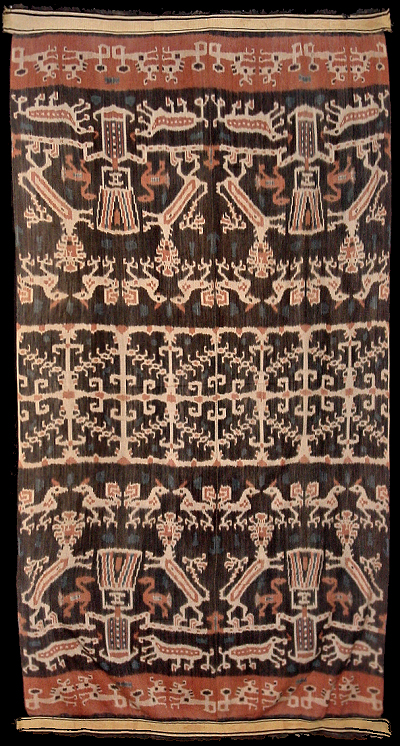| |
 
 | | | |
065 Sumba, East Sumba
Hinggi (men's blanket) 
| | Locale: | Kanatang (or Mangili, Kambera, Rende) | | Period: | 1920-1940 | | Yarn: | Cotton, hand-spun, fine | | Technique: | Warp ikat | | Panels: | 2 | | Size: | 130.5 x 231.5 cm (4' 3" x 7' 7") LW: 1.77 | | Weight: | 775 g (27.3 oz), 257 g/m2 (0.84 oz/ft2) | | Design: | Mounting lions protecting a coat of arms, a motif derived from Dutch heraldry, and intended to symbolize and manifest the power of the wearer. At the feet of the lions we see snakes and what appear to be chickens, The lions' heads are flanked by pairs of (fighting) cocks. The shields are flanked by pairs of shrimp, which stand for nobility and the power to grow beyond one's limits. Unusual midfield, la padua or kundu duku, with pattern named buanda, which according to one source at the time belonged exclusively to the family of the Raja of Kanatang, but was later also used in Mangili, Kambera and Rende. | | Comment: | A powerful hinggi with bold motifs that radiate power. Very good ikat work (note the smooth diagonals, e.g. in the mounting lions' backs) executed in morinda, indigo and a purplish black created by overdying morinda with indigo. Somewhat faded, otherwise in excellent state of preservation. As the fringes are short, the type of thread could only be established by means of micro-photography - which clearly shows the irregularities of hand spun (see below). Yarn is brittle with age, with filaments peeling off at odd angles. From old Dutch collection. | | Background: | Chapters on Sumba and East Sumba. | | Compare: | 019 072 073 152 | | Sources: | Very similar to hinggi in Khan-Majlis, Woven Messages, Fig. 215, which however is both younger and more naturalistically drawn. Khan Majlis there calls the division in three main ikated areas indicative of late manufacture, contradicting herself - uncharacteristically - as in Indonesische Textilien, Wege zu Goettern und Ahnen, on Fig. 407, she shows a hinggi from around 1900 with a three-field lay-out. Given this additional example we may safely conclude that deviation from the classic eleven band structure predates the end of the colonial period. Midfield similar to hinggi on Fig. 419 of the same title. Similar midfield motif in Langewis and Wagner, Decorative Art in Indonesian Textiles, Fig. 149. Buanda motif identified by Sumbanese weaver Freddy Hambuwali. | | |

©Peter ten Hoopen, 2024
All rights reserved.
|
|


